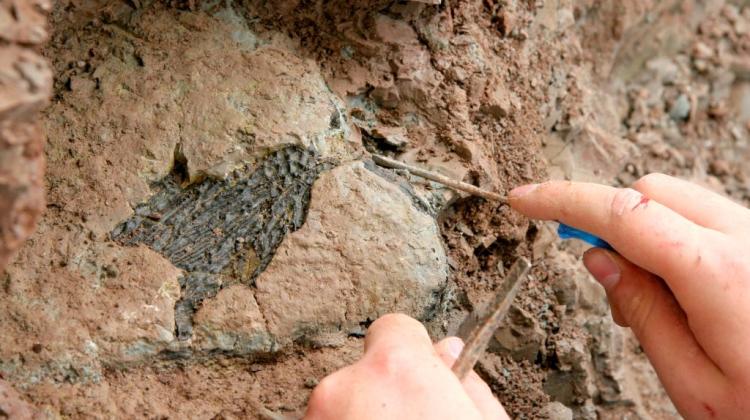Konietzko-Meier: fossil amphibian from Krasiejów could cope with drought

Metoposaurus diagnosticus that lived in the vicinity of today’s Krasiejów 230 million years ago, adapted to the dry season by burying itself in the ground. Scientists describe the life of the amphibian in the Journal of Vertebrate Paleontology.
Metoposaurus diagnosticus was a giant amphibian, weighing half a ton and measuring about three meters. Like all amphibians, it needed water. Study co-author, Dr. Dorota Konietzko-Meier of the University of Opole told PAP that there were the only two seasons near Krasiejów - wet and dry. During the wet season, water level was high and a lake appeared. Then came the dry season with wetland environment and small ponds.
"In general, little is known about the histology (tissue structure - PAP ) of large amphibians compared to the dinosaurs, which have been under +intense fire+ for a few dozen years. Big amphibians have somehow been forgotten - explained the researcher. - Because of this, our work was quite an overview, we wanted to cut many different bones of different sizes and different types of a single species. This way you can see if there are any common features, development trends, try to determine the age and growth rate".
She added that the metoposaur from Krasiejów was perfectly suited for this purpose, because it was very common, and scientists had access to a great diversity of bones.
The research was conducted in cooperation with Prof. Martin Sander from the University of Bonn. "What surprised us under the microscope, was the system of growth areas. In warm-blooded animals you can see growth lines - - like rings in trees. This system was completely different from today\'s amphibians and different from the other fossil vertebrates. Simply put, today\'s amphibians have a wide area of rapid growth (corresponding to the optimal conditions - a lot of food , temperature, etc.), and during the harsh period a growth arrest line occurs" - described Konietzko-Meier.
However, in Krasiejów, in addition to the normal zones of rapid growth, there are broad areas of very slow growth. "This is evidence of long term worse living conditions. During these periods, growth rate was slow, but present. It was not bad enough for amphibians to hibernate" - she added.
The article suggests, as a hypothesis, the possibility of periodic bogging down of the metoposaur.
"Amphibians from Krasiejów had short legs with strong muscles, which we know from histological analysis. Remains of muscle attachments are visible under the microscope. Therefore, we associated strong , muscular legs (too short to walk and at all unsuitable for swimming) with a long period of low water level, and came to the conclusion that perhaps these amphibians in the juvenile period (because only these bones we have in Krasiejów) could have to dig in loose mud.
Nowadays, bogging down in the mud is common, also among amphibians. But we must remember that today\'s amphibians are miniature creatures compared to the Triassic animals" - she explained.
Dr. Konietzko-Meier pointed out that little is known about amphibians and their histology. "Our team has intensified its efforts in this direction. We work with the University of Bonn and Professor Sander (now probably the best specialist in the field paleohistology) . And Krasiejów keeps providing new material and new inspirations" - she concluded.
PAP - Science and Scholarship in Poland
krx/ ula/ agt/ mrt/
tr. RL
Przed dodaniem komentarza prosimy o zapoznanie z Regulaminem forum serwisu Nauka w Polsce.














